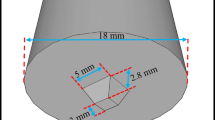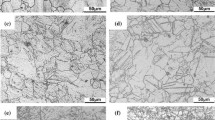Abstract
Texture evolution and plastic deformation mechanism of the weld zones of magnetic pulse welded dissimilar 1060 pure Al and AZ31B Mg alloy have been investigated in the present work. A much refined microstructure with smaller grains and higher hardness was observed near the weld interface which has different texture types compared to the BM (base material) at both the Al side and the Mg side. The intermetallic layers at the interface of the Al side and the Mg side have the highest hardness. The region near the weld interface has higher activity of both slip and twinning. Slip occurs on two planes (111) and (\( \overline{1} \)11) in the Al BM, while the active slip systems in the Al region near the weld interface are on four planes (111), (11\( \overline{1} \)), (\( \overline{1} \)11) and (1\( \overline{1} \)1). The transition of single texture in the BM to complex texture type in the region near the weld interface at both the Al side and the Mg side was due to {111} slip and {10\( \overline{1} \)2} twinning, respectively.













Similar content being viewed by others
References
Weman K (2003) Welding processes ehandbook (Cambridge: Woodhead publishing ltd, England, and CRC Press LLC, North America, USA), pp. 94–101
Kapil A, Sharma A (2015) Magnetic pulse welding, an efficient and environmentally friendly multi-material joining technique. J Clean Prod 100(1):35–58
Jassim AK (2011) Magnetic pulse welding technology. Iraq J Electr Electron Eng 7(2):169–179
Kochan A (2000) Magnetic pulse welding shows potential for automotive applications. Assem Autom 20(2):129–132
Shribman V, Blakely M (2008) Benefits of the magnetic pulse process for welding dissimilar metals. Weld J 87(9):56–59
Wu X, Shang J (2014) An investigation of magnetic pulse welding of Al/Cu and interface characterization. J Manuf Sci Eng 136(5):1–10
Cui J, Sun G, Xu J, Xu Z, Huang X, Li G (2016) A study on the critical wall thickness of the inner tube for magneticpulse welding of tubular Al-Fe parts. J Mater Process Technol 2(27):138–146
Kastensson A (2014) Developing lightweight concepts in the automotive industry, taking on the environmental challenge with the SaNatt project. J Clean Prod 66(66):337–346
Cui J, Sun G, Li ZX, Chu PK (2014) Specific wave interface and its formation during magnetic pulse welding. Appl Phys Lett 105(22):1–3
Nassiri A, Chini G, Kinsey B (2014) Spatial stability analysis of emergent wavy interfacial patterns in magnetic pulsed welding. CIRP Annals- Manuf Technol 63(1):245–248
Kore SD, Imbert J, Worswick MJ, Zhou Y (2009) Electromagnetic impact welding of Mg to Al sheets. Sci Technol Weld Join 14(6):549–553
Ben-Artzy A, Stern A, Frage N, Shribman V, Sadot O (2010) Wave formation mechanism in magnetic pulse welding. Intl J Impact Eng 37:397–404
Stern A, Aizenshtein M (2011) Magnetic pulse welding of Al to Mg alloys, structural-mechanical properties of the interfacial layer. Mater Sci Technol 27(12):1809–1813
Stern A, Aizenshtein M, Moshe G, Cohen SR, Frage N (2013) The nature of interfaces in Al-1050/Al-1050 and Al-1050/Mg-AZ31 couples joined by magnetic pulse welding (MPW). J Mater Eng Perform 22(7):2098–2103
Chen S, Xia Y, Yu Y, Bai L, Lu Z (2012) Research on the interface morphology of magnetic pulse welded Al-Mg alloy. Rare Metal Mater Eng 41(2):352–354
Stern A, Shribman V, Ben-Artzy A, Aizenshtein M (2014) Interface phenomena and bonding mechanism in magnetic pulse welding. J Mater Eng Perform 23(10):3449–3458
Zhang Y, Babu S, Daehn GS (2010) Impact welding in a variety of geometric configurations (the 4th International Conference on High Speed Forming Proc., Ohio, USA), p. 97–107
Berlin A 2010 Magnetic pulse welding of Mg sheet, Mater thesis, University of Waterloo, Canada
Berlin A, Nguyen TC, Worswick MJ, Zhou Y (2010) Metallurgical analysis of magnetic pulse welds of AZ31 magnesium alloy. Sci Technol Weld Join 16(8):728–734
Markashova L, Arsenyuk VV, Grigorenko GM (2005) Relationship governing plastic deformation in pressure welding dissimilar metals. Weld Int 19(1):68–72
Zhen L, Zou DL, Xu CY, Shao WZ (2010) Microstructure evolution of adiabatic shear bands in AM60B magnesium alloy under ballistic impact. Mater Sci Eng A A527:5728–5733
Zhang L (2008) A study of influence factors on interface microstructure and properties of explosive welding of composite materials, Master thesis, Nanjing University of Technology, China
Chiba A, Nishida M, Morizono Y (2004) Microstructure of bonding interface in explosively-welded clads and bonding mechanism. Mater Sci Forum 465-466:465–474
Preuss M, Quinta da Fonseca J, Allen V, Prakash DGL, Daymond MR (2010) Twinning in structural material with a hexagonal close-packed crystal structure. Spec Issue Pap J Strain Anal 45(5):377–389
Bhattacharya R 2010 Hot deformation studies on Mg AZ31 alloy using plane strain compression (PSC) machine. PhD thesis, The University of Sheffield, UK
Ahmed MMZ (2009) The development of thick section welds and ultra-fine grain Al using friction stir welding and processing. PhD thesis, the University of Sheffield, UK
Plummer J (2012) PhD thesis, the University of Sheffield, UK
Bunge HJ (1982) Texture analysis in materials science, mathematical methods, lst edn. Butterworth & Co., Berlin, pp 6–20
Huang Y, Humphreys FJ, Ferry M (2000) The annealing behaviour of deformed cube oriented aluminium single crystals. Acta Mater 48(10):2543–2556
Humphreys FJ (2001) VMAP software, Manchester Materials science Centre, the University of Manchester
Humphreys FJ, Hatherly M (2004) Recrystallization phenomenon and related annealing phenomena, 2nd edn. Elsevier, Amsterdam, pp 268–320
Pedrosa ML (2007) An analysis of microstructure evolution in hot worked Al subjected to non-linear deformation. PhD thesis, the University of Sheffield, UK
Bishop JFW, Hill R (1951) A theoretical derivation of the plastic properties of a polycrystalline face-centred metal. Philos Mag 42(334):1298–1307
Randle V (2004) Application of electron backscatter diffraction to grain boundary characterization. Int Mater Rev 49(1):1–11
Wang Y, Chen M, Zhou F, Ma E (2002) High tensile ductility in a nanostructured metal. Nature 419:912–915
Goodhew PJ (1979) Annealing twin formation by boundary dissociation. Metal Sci 13(3–4):108–112
Wang YN, Huang JC (2003) Review texture analysis in hexagonal material. Mater Chem Phys 81(1):11–26
Gehrmann R, Frommert MM, Gottstein G (2005) Texture effects on plastic deformation of magnesium. Mater Sci Eng A 395(1):338–349
Yang P (2007) Electron backscatter diffraction technique and its application, 1st edn. Metallurgical Industry Press, China, p 146
Balasubramanian S (1998) Polycrystalline plasticity, application to deformation processing of lightweight metals, PhD thesis, Massachusetts Institute of Technology, USA
Staroselsky A, Anand L (2003) A constitutive model for hcp materials deforming by slip and twinning, application to magnesium alloy AZ31B. Int J Plast 19(10):1843–1864
Ando S, Tsushida M, Kitahara H (2012) Plastic deformation behavior in magnesium alloy single crystals. Mater Sci Forum 706-709:1122–1127
Wright SI (1993) A review of automated orientation imaging microscopy (OIM). J Comput Assist Micros 5(3):207–221
Mason TA, Adams BL (1994) The application of orientation imaging microscopy. J Miner Met Mater Soc 46(10):43–47
Hong SG, Park SH, Lee CS (2010) Role of {10-12} twinning characteristics in the deformation behavior of a polycrystalline magnesium alloy. Acta Mater 58(2):5873–5885
Reed-Hill RE, Abbaschian R (1994) Physical metallurgy principles, 3rd edn. MA, Boston
Jiang J, Godfrey A, Liu W, Liu Q (2008) Identification and analysis of twinning variants during compression of a Mg-Al-Zn alloy. Scr Mater 58(2):122–125
Yang P, Yu Y, Chen L, Mao W (2004) Experimental determination and theoretical prediction of twin orientations in magnesium alloy. Scr Mater 50(8):1163–1168
Nave MD, Barnett MR (2004) Microstructures and textures of pure magnesium deformed in plane-strain compression. Scr Mater 51(9):881–885
Clausen B, Leffers T, Lorentzen T, Pedersen OB, Houtte PV (1999) The resolved shear stress on the non-active slip systems in taylor/bishop-hill models for fcc polycrystals. Scr Mater 42(1):91–96
Hirsch J, Nes E, Lücke K (1987) Rolling and recrystallization textures in directionally solidified aluminium. Acta Metall 35(2):427–438
Saito Y, Tsuji N, Utsunomiya H, Sakai T, Hong RG (1998) Ultra-fine grained bulk aluminum produced by accumulative roll-bonding (ARB) process. Scr Mater 39(9):1221–1227
Vatne HE, Engler O, Nes E (1997) Influence of particles on recrystallisation textures and microstructures of aluminium alloy 3103. Mater Sci Technol 13(2):93–102
Hirsch J, Lṻcke K, Matherly M (1988) Overview NO. 76 Mechanism of deformation and development of rolling textures in polycrystalline fcc metals---III The influence of slip inhomogeneities and twinning. Acta Metall 36(11):2905–2927
Hirsch J, Lṻcke K (1988) Overview no. 76: Mechanism of deformation and development of rolling textures in polycrystalline fcc metals—I Description of rolling texture development in homogeneous CuZn alloys. Acta Metall 36(11):2863–2882
Yeung WY, Hirsch J, Hatherly M (1989) Rolling and annealing of fine grained 70:30 brass. Textures Microstructures 10(2):135–152
Wasserman G (1963) Der Einfluss mechanischer Zwillingsbildung auf die Entstehung der Waltztexturen Kubisch flacheuzentrierter (The influence of mechanical twinning to the emergence of Waltz FCC texture). Metalle Z Metall 54:61
Engler O, Heckelmann I, Rickert T, Hirsch J, Lucke K (1994) Effect of pretreatment and texture on recovery and recrystallisation in AI-4-5Mg-O-7Mn alloy. Mater Sci Technol 10(9):771–782
Guiglionda G, Borbély A, Driver JH (2004) Orientation-dependent stored energies in hot deformed Al–2.5% Mg and their influence on recrystallization. Acta Mater 52(12):3413–3423
Saxl I, Haslingerová I (1974) Double prismatic slip in textured Mg-2 percent Be alloy. Czech J Phys B 24(12):1351–1361
Gehrmann R, Frommert MM, Gottstein G (2005) Texture effects on plastic deformation of magnesium. Mater Sci Eng A 395(1–2):338–349
Ung’ar T, Glavicic MG, Balogh L, Nyilas K, Salem AA, Ribárika G, Semiatin SL (2008) The use of X-ray diffraction to determine slip and twinning activity in commercial-purity (CP) titanium. Mater Sci Eng A 493:79–85
Agnew SR, Yoo MH, Tome CN (2001) Application of texture simulation to understanding mechanical behavior of Mg and solid solution alloys containing Li or Y. Acta Mater 49(20):4277–4289
Yi SB, Davies CHJ, Brokmeier HG, Bolmaro RE, Kainer KU, Homeyer J (2006) Deformation and texture evolution in AZ31 magnesium alloy during uniaxial loading. Acta Mater 54:549–562
Funding
This study was funded by the Ministry of Education Research Fund for the doctoral program of P.R. China (Grant No. 20111003110003) and the National Natural Science Foundation of China (Grant No. 51575012).
Author information
Authors and Affiliations
Corresponding author
Additional information
Recommended for publication by Commission III - Resistance Welding, Solid State Welding, and Allied Joining Process
Rights and permissions
About this article
Cite this article
Jiang, X., Chen, S. Texture evolution and plastic deformation mechanism in magnetic pulse welding of dissimilar Al and Mg alloys. Weld World 62, 1159–1171 (2018). https://doi.org/10.1007/s40194-018-0607-5
Received:
Accepted:
Published:
Issue Date:
DOI: https://doi.org/10.1007/s40194-018-0607-5




